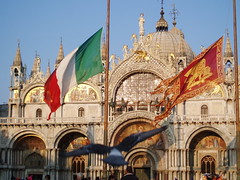 Venice (Photo credit: BillT)
Venice (Photo credit: BillT)Author: Albapp
It seems hard to believe today that it was the excess of bachelors during the eighteenth century what gave birth to one of the most representative figures of the century of Lights in Italy, and specially in Venice. However, this was the real reason that lead to the existence of the cicisbeo, the gallant partner, not married to the noble lady who is often represented in important paintings of the period as a main character or as a secondary one.Most of the time, the cicisbeo was one of the younger sons of a noble family, bound to celibacy or the seminar for not being first-born. The latter owning all the family's property, the choice of the younger ones was between a life in the Church or a life of relative luxury next to a lady. Many, as one can expect, chose the last one.
Men who have been identified as cicisbei appear in the works of artists such as Tiepolo and Longhi. They are chosen by a lady's family and close entourage even before the husband was. In fact, it was custom that the spouse know before the wedding the man who was going to spend most of the time with his wife. It was not estrange that the name of the gallant appeared in the marriage contract either.
Scenes represented in paintings of the eighteenth century having the cicisbeo as a main character are true to the tasks and daily routines they tend to be in charge of. Being an assistant-partner to the dame, cicisbei usually attended the woman's morning toiletries, accompanied them in walks or to the theater, recited poems and caused about a variety of topics. Many works of art also portray the cavaliers talking to the dame and her closer entourage.
Such was this figure's importance during the century of Lights that in the Carnival of Venice it is common to see around the streets a mask inspired by this men, in particular the cicisbeo of Boccaccio's Decameron. The character was actually a recurrent one in the satires of the Italian comedy (like the ones by the legendary Goldoni), but was also found in operas like The Marriage of Figaro.
References do not end here though, since this Venetian gentlemen also known as serving cavaliers, are often found in the written production that flourished during this period, like Alfieri's memoirs and the poems by Parini.
The relationship between the noble lady and the cicisbeo was to be, in theory, a platonic one. In fact the liaison was closer to friendship than to love most of the time, the gallant being a confident and friend to the dame and a protection guarantee to the husband for the public outings of his wife.
Venice is filled with references to this curious character that found both support and critics in Europe. The next tie you visit Venice, open your eyes and look closely at the art of the eighteenth century, the profile of the cicisbeo will pop up in many scenes.
Article Source: http://www.articlesbase.com/destinations-articles/venice-cavaliers-the-gallants-of-the-eighteenth-century-5832033.html
About the Author
Written by Alba L with support from deals hotel.
Visit eatery in Venice or Venice hotel booking for further details.
E-Book
Print Book
